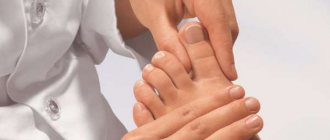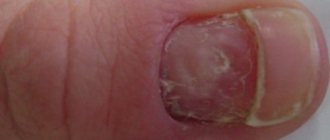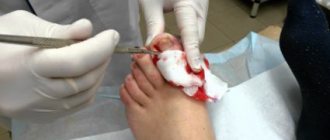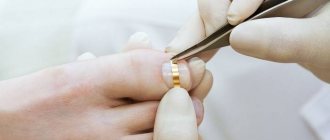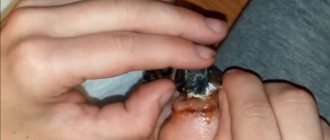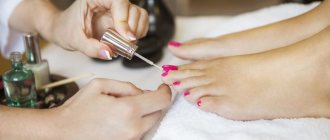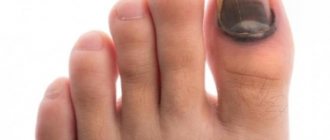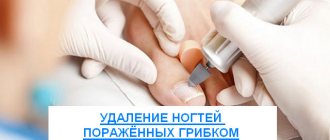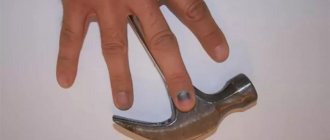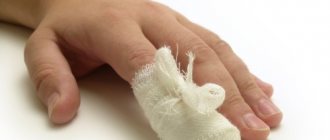More about the operation
A poorly or poorly done pedicure, fungal infections, flat feet, tight narrow shoes, injuries - all this threatens the deformation and ingrowth of the nail plate into the soft tissue.
Currently, ingrown toenail removal is performed using modern, low-traumatic techniques aimed at speedy recovery. Electroradio wave surgery is used to remove or trim an ingrown nail plate. This allows, even in the most difficult clinical cases, to minimize surgical trauma and ensure a short healing period. These procedures are performed using “one-day surgery” technology and are carried out in an outpatient operating room. After the procedure, you can go home straight away. Preparation for the intervention is minimal, and the operation itself lasts a few minutes.
Proper care after nail plate removal
After any procedure, the operated nail needs care and rest. In order for the recovery period to be effective and efficient, you need to adhere to the following rules:
- Try not to put your body weight on the affected limb.
- If a toenail has been removed, you should try to provide rest to the problematic horny plate.
- Take painkillers if necessary.
- Before pedicure or dressing, thoroughly disinfect your hands.
- Always wear clean socks and comfortable shoes throughout the rehabilitation period.
- Be sure to ask a specialist whether you can take a shower.
Why do you need to have surgery?
A finger with an ingrown nail swells, suppurates and hurts, which leads to impaired functionality - it becomes difficult to even just walk, not to mention intense physical activity. In addition, penetration of pus deeper into the tissue can provoke serious complications, including phlegmon or gangrene of the finger.
The big toes are the most susceptible to ingrown toenails. Conservative methods of treating such a problem are not always effective. The radical treatment method is surgery.
Why choose us
The outpatient surgery department of the GMS Clinic uses the entire arsenal of the latest techniques for surgical treatment of ingrown toenails - the classical approach, laser and radio wave surgery. The operations are performed by experienced surgeons with many years of experience. We use only the most effective intervention techniques that avoid relapses and provide the following benefits:
- minimal trauma to surrounding tissues;
- fast healing;
- painlessness of the procedure;
- 100% sterility;
- minimizing complications and relapses.
GMS Hospital specialists successfully perform surgeries for resection of ingrown toenails of any degree of complexity.
Cost of ingrown toenail removal
The prices indicated in the price list may differ from the actual prices. Please check the current cost by calling +7 495 104 8605 (24 hours a day) or at the GMS Hospital clinic at the address: Moscow, st. Kalanchevskaya, 45.
| Name | Common price | Price with 30% discount |
| Operations for ingrown toenails | RUB 37,410 | RUB 26,187 |
| Nail removal | RUB 13,460 | RUB 9,422 |
Prices for the most popular services are indicated with a 30% discount, which is valid when paying in cash or by credit card. You can be served under a VHI policy, pay separately for each visit, sign an agreement for an annual medical program, or make a deposit and receive services at a discount. On weekends and holidays, the clinic reserves the right to charge additional payments according to the current price list. Services are provided on the basis of a concluded contract.
Plastic cards MasterCard, VISA, Maestro, MIR are accepted for payment. Contactless payment with Apple Pay, Google Pay and Android Pay cards is also available.
Make an appointment We will be happy to answer any questions Coordinator Oksana
In what cases is it necessary to contact a surgeon?
The indication for surgical intervention is the ingrowth of the nail plate into the periungual fold and the recurrent course of the disease. Make an appointment with a surgeon if the following symptoms appear:
- the skin around the nail turned red, soft tissue swelling and pain appeared;
- the pain intensifies when you press on a nail or finger, as well as when walking;
- suppuration and the appearance of purulent exudate from under the nail plate;
- growth of the periungual fold, overhang of its edge over the nail plate.
Symptoms increase with the progression of the pathological process. There is no need to suffer from pain and try to get rid of an ingrown toenail using numerous traditional methods. While you are experimenting, the situation may turn in an even more complicated direction, just make an appointment with a surgeon - one simple, painless manipulation and you will quickly forget about such a problem as an ingrown toenail.
What are the indications and contraindications for removing an ingrown nail plate?
The most common method of treating an ingrown plate is surgical removal. There must be serious indications for this procedure. As a rule, removal of the nail by surgical intervention is prescribed to patients with an advanced stage of the disease, since a conservative treatment method is no longer meaningful.
Without any doubt, doctors prescribe surgical removal to patients when pus and ichor begin to ooze at the site of ingrowth. Also, the main indication is the proliferation of soft tissue.
Therefore, in order to cure this disease using a conservative technique, it is necessary to turn to specialists for help in time. If you leave everything to chance, you will have to completely remove the nail plate.
Fortunately, our medicine does not stand still. More recently, to solve a similar problem, it was necessary to completely remove the nail plate, but now this can be avoided. The latest technologies make it possible not only to eliminate the problem, but also to correct the nail plate.
Surgical treatment is contraindicated if: the patient is taking certain medications that can disrupt the blood clotting process (aspirin and all its analogues); the patient was diagnosed with problems with the endocrine system, including diabetes; the patient suffers from diseases of the vascular system.
Preparation, diagnostics
The clinical picture of the disease is quite specific, which allows the doctor to make the correct diagnosis by visual examination. As a rule, no additional research methods are required. Standard preoperative preparation includes:
- blood analysis;
- if the cause of an ingrown nail is a fungal infection, an additional microbiological analysis of a piece of the nail is performed;
- in case of severe inflammation, if there is a suspicion that the pathological process has affected bone tissue, an x-ray is prescribed
Since ingrown toenails are in most cases accompanied by tissue suppuration, antibiotic therapy is often prescribed to suppress the infection and prevent possible complications.
Classic nail removal
Comes in two variations:
- complete removal of the nail. Used in the presence of a pronounced inflammatory process or suppuration of soft tissues;
- partial removal of the nail with small excision of the growth zone. It is performed when the nail fold is thick and there are no signs of inflammation.
The operation is highly effective. It is performed under local anesthesia by interstitial injection of a solution of novocaine or lidocaine. Healing occurs 7 to 10 days after surgery.
The disadvantages are the possible development of complications in the form of cessation of nail growth due to complete destruction of the growth zone during surgery. In the early postoperative period, severe bleeding from the postoperative wound is possible.
How is the operation performed?
Removal of an ingrown toenail is carried out under local anesthesia, therefore, the most painful thing that the patient can feel is the anesthetic injection. The surgeon cuts off the ingrown nail plate or the edge of the plate and carefully removes granulation growths formed in the area of the ingrown nail. Healthy tissues and the nail bed remain unaffected.
If necessary, excision of the periungual ridges is performed (for cosmetic purposes). Complete removal of the nail plate along with the growth zone is used very rarely, only in cases of severe fungal infection of the nail. The final step is to apply a sterile bandage with an antiseptic.
The classic operation involves suturing the wound - modern electro-radio wave technologies make it possible to do without sutures. The surgical wound heals under the formed crust. The absence of a seam provides a good cosmetic effect, no scars in the area of intervention.
Healing takes from several days to 1-2 weeks. The procedure takes only 20-30 minutes, is less traumatic and minimizes relapses in the future.
You have questions? We will be happy to answer any questions Coordinator Tatyana
Removing a nail for fungal infection
As mentioned above, fungus is especially dangerous for the health of the nail plates, so it is important to take preventive measures and observe basic rules of personal hygiene. If the problem does occur, it’s time to go to an appointment with a dermatologist. It is this highly specialized specialist who determines the nature of the pathology, prescribes treatment and can predict the actual clinical outcome.
In case of fungal infection, the nail plate must be immediately removed, followed by the administration of antifungal agents. You can remove a yellowed nail using tweezers at home, but you will first need to buy a local painkiller - Lidocaine. It is necessary to soak the nail, then wipe it with a towel and carefully treat it with Lidocaine. After this, remove the remaining nail plate with tweezers and scissors, disinfect the wound and wrap it with a sterile bandage to avoid extremely unwanted infection.
Features of the rehabilitation period
Complete healing lasts 1-2 weeks, which depends on the volume of intervention and the surgical tactics used. During this period, it is necessary to carefully protect the wound from infection, regularly change dressings, using antiseptics and wound healing agents prescribed by the surgeon.
It is necessary to minimize the load on the operated finger and the limb as a whole - do not put stress on the leg, protect it from injury, wear comfortable, loose shoes. Ingrown toenail removal is carried out at the GMS clinic daily, by appointment. To make an appointment with a surgeon, call the reception desk or leave a request on the website.
Symptoms to remove an ingrown toenail
How to understand that you are faced with an ingrown toenail problem? The following signs will indicate this:
- hyperemia (redness) of soft tissues;
- the appearance of swelling around the nail fold;
- blueness of the skin of the big toe;
- purulent discharge;
- visually noticeable increase in the size of the big toe;
- a pain symptom that suddenly appears while walking (the problem is especially acute when wearing narrow shoes);
- pain that persists even at rest.
If any of the above symptoms appear, you must see a surgeon. You should not self-medicate, or try to solve the problem using traditional methods. Despite the fact that removing an ingrown toenail seems a scary prospect to many, modern medicine allows this operation to be performed with minimal discomfort for the patient.
Causes
Why does my big toe nail grow in? This question is rightly asked by patients who have difficulty choosing shoes and pain when walking. But in fact, there are a number of circumstances that contribute to the occurrence of onychocryptosis:
- individual predisposition (unfortunately, the tendency to develop such a pathological condition can be inherited);
- improper cutting of toenails (lack of regular care, cutting the nail plate along a rounded line);
- wearing tight shoes;
- mechanical injury to the finger;
- flat feet, meaning deformation of the foot;
- fungal infection of the nail plate;
- a profession that involves a disproportionate load on the legs;
- Poor circulation of the feet and toes.
Caution - danger!
Why can’t you buy an “anti-inflammatory” ointment at the pharmacy and try to solve the problem at home yourself? The fact is that onychocryptosis can cause serious diseases of the soft tissues and even the bones of the finger. Only a doctor can assess the severity of the situation and propose an adequate treatment plan.
If proper treatment is not started in time, the abscess can turn into a tumor. At this stage of the disease, the patient can only walk using special shoes.
Delaying a visit to the doctor can only make the problem worse. Do not risk your health; if you have an ingrown toenail, contact a qualified doctor promptly.
Ingrown toenail removal procedure
There are several methods to solve this problem:
- a surgical operation that involves complete removal of the nail plate (when the nail is removed along with the growth zone, and the resulting defect is covered with a skin flap; it is worth considering that when using this technique, the removed plate does not grow back; this technology is used in particularly advanced cases);
- surgery - partial removal of the nail (implies a more gentle effect; depending on the location of the inflammatory process, it is possible to remove different parts of the nail plate);
- laser removal (an innovative technique, painless, showing high effectiveness and preserving the aesthetic appearance of the nail).
Preparation
As a rule, before surgery to remove an ingrown toenail, the patient is prescribed the following examinations:
- a general blood test (done if a fungus is suspected; if mycosis is confirmed, the doctor must prescribe treatment with antifungal drugs);
- general urine analysis ;
- bacteriological analysis;
- if suppuration occurs, the doctor must prescribe antibiotics;
- blood test for sugar and drug sensitivity (for patients with diagnosed diabetes and allergies);
- X-ray (for 100% accurate diagnosis or in case of particularly severe inflammation);
Also, at the time of preparation for surgery to remove an ingrown nail, the doctor decides on the scale - the nail plate will be completely or partially removed. Of course, it is preferable for both the doctor and the patient to preserve the integrity of the nail as much as possible, but this decision directly depends on the degree of tissue damage and the neglect of the case.
